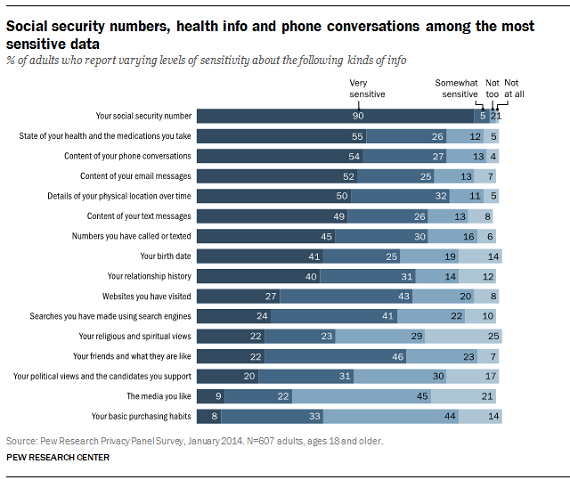|
|
|
Archive for 2014
Monday, November 24th, 2014

Thursday is the opening of family-get-together season; a time of high stress for many, i.e., a time of battles, large and small.
This is also the time of year that the media trots out dozens of therapists, coaches, etc., to advise on how to handle family get-togethers.
But I think they miss the point.
Connecting for a better relationship isn’t the aim when Uncle Harry drinks too much and starts on his standard rant of what’s wrong with today’s society, etc., etc, etc.
What’s needed are hardcore negotiating skills.
And who better to share them in time for the start of family-get-together season than real hostage negotiators who handle potentially violent confrontations for a living?
I have often wondered, How might a hostage negotiator help the average American family get through Thanksgiving? (…) Surely these are matters for professionals who’ve received months of intensive training in crisis intervention?
Perfect.
Read the article, practice on a like-minded friend between now and Thursday and you’ll have the skills to handle everything Uncle Harry, cousin Rebecca or anyone else might throw your way.
Flickr image credit: Tambako The Jaguar
Posted in Communication, Just For Fun | No Comments »
Friday, November 21st, 2014
A Friday series exploring Startups and the people who make them go. Read all If the Shoe Fits posts here
 “Culture eats strategy for breakfast/lunch/dinner” has become the byword among the startup community and for good reason. “Culture eats strategy for breakfast/lunch/dinner” has become the byword among the startup community and for good reason.
Culture is what attracts talent; it’s why they stay and when it changes it’s why they leave.
Of course, that refers to good culture.
Many founders buy into prevailing myths, such as programmers live to program and allow 80+ hour weeks to become the norm.
The founder who got trounced on Quora is a good example of problematic values.
- He calls himself a CEO, but “manages a startup” with one employee.
- His employee is a new dad and always leaves between 6-7pm, but he also indicates that the work is getting done.
- He says “it’s hard for a startup that the commitment lasts for work hours only,” but gives no indication that there is founder or any kind of equity on the table.
- He disregarded the negative feedback and defended his concerns, basically saying ‘you’re all wrong and the problem isn’t me’.
He ignored the research that shows productivity takes a nosedive after 40 hours.
…employees simply become much less efficient: due to stress, fatigue, and other factors, their maximum efficiency during any given work day may become substantially less than what it was during normal working hours.
I’ve know thousands of programmers over the years and not one has ever claimed that the code written after 12+ hours was particularly usable and code done during all-nighters often wasn’t even salvageable.
Much worse, and predictive of serious problems to come, was his refusal to entertain the idea that he was wrong.
I especially appreciated the response from Drew Austin, Co-Founder of Augmate, who took time to explain how he had been there/almost done that and thanked his lead engineer for helping him change.
**Special thanks to our lead engineer Alex. If it wasn’t for his patience and ability to communicate, I would have been the one writing this question, instead of responding to it.*
I hope you take time to read the whole thread; it’s a crash course in how to build a great culture.
Because great cultures pay off in real money.
Image credit: HikingArtist
Posted in Culture, If the Shoe Fits | No Comments »
Thursday, November 20th, 2014

How much money are you trying to raise?
Are you more focused on funding or on growing your business?
Do you read about huge valuations and the resulting funding and find yourself green with envy?
According to Ron Conway, founder of SV Angel, …it’s always good to bootstrap for as long as possible, meaning it’s better to not take money from a venture capitalist or angel investor; startups should strive to be self-sustaining at first.
When fundraising it’s important to know what you really need as opposed to what you can get.
Ego trips, too, play a role in fundraising. After all, think of the bragging rights and the media frenzy that come with large investments.
But raising funds means giving up equity as Xenios Thrasyvoulou, founder of PeoplePerHour.com and SuperTasker.com in London and New York, learned the hard way.
…venture capitalists expected his company to grow five times in 12 months. Though he viewed his firm as having a healthy, sustainable growth rate, it didn’t meet those expectations, and he was forced to hire an expensive and large management team. Eventually, Thrasyvoulou regained control of his company, but he reminds other entrepreneurs that “sanity is more important than vanity.”
Of primary importance for all founders is to remember that what goes up always comes down—especially the economy.
That means not just careful fundraising, but careful spending; it’s far smarter to bank the money than to spend it on plush startup living.
Read the article and learn from those who can say, been there/done that. It’s not the same as listening to them on-stage, but it’s a lot less expensive.
Flickr image credit: Howard Lake
Posted in Entrepreneurs | No Comments »
Wednesday, November 19th, 2014

What do SAS; Warby Parker and Toms Shoes; FullContact; Petagonia have in common?
Flexibility, AKA work/life balance.
I’ve written about all of them and for the same reason—they get it.
They get that people are their most valuable asset; they get that replacing them costs far more than the cost of an ad; they get that top talent is looking for more than a fat paycheck.
Lisa Horn, who tracks workplace policies for the Society for Human Resource Management, which represents more than 200,000 members from the HR departments of companies around the world, said many businesses, which, since the Great Recession, have forced employees do more with less, are facing new realities: Millennials who value time for both work and life, and fierce competition for the most highly skilled employees who can easily jump ship for something better. “Already 87 percent of employees say flexibility and balance is important or very important in their next job. So it would behoove companies to adopt these strategies for competitive advantage.”
Companies that get it thrive and not just in the short term.
SAS has been doing it successfully since 1976; so much so that Google’s very own Larry Page and Sergy Brin visited to learn SAS’ approach.
Family-owned Patagonia has doubled in size and tripled in profits since 2008; it has 2,000 employees around the globe and minimal turnover.
A comment from TSD (10/24/2014 5:38) on the Petagonia article sums it up nicely.
I never have figured out why treating your workers well is such a hard concept for so many businesses. I work harder and faster and better when I’m happy and not terrified. Granted, I’ve never owned a business, but it seems pretty simple. Miserable workers will not be productive.
It’s not rocket science—or maybe it is.
Flickr image credit: Steve Jurvetson
Posted in Culture, Motivation, Retention | No Comments »
Tuesday, November 18th, 2014

Ever head the old French proverb, ‘the more things change the more they stay the same’?
Ever since the advent of modern business, managers have faced the same conundrum, i.e., how do you accomplish your objectives when your resources (human or other) are continually reduced or the objectives are significantly expanded, but the staff isn’t.
Walmart is the most recent poster child for this approach and it is especially obvious in the fresh grocery section.
“Labor hours have been cut so thin, that they don’t have the people to do many activities,” said Burt P. Flickinger III, a retail consultant. “The fact that they don’t do some of these things every day, every shift, shows what a complete breakdown Walmart has in staffing and training.”
Walmart continually sends out detailed memos of work that needs to be done daily, such as discounting older meat and eggs, testing/filtering deli oil and watering plants, but adds a rider that practically guarantees managers inability to perform.
At the same time, the memo warns managers not to exceed the weekly hours assigned to their stores. It tells managers to examine whether they are assigning employees too many hours or overtime beyond what the company had budgeted.
Walmart’s employment numbers are misleading, too, since it would require an additional 200,000 workers to have kept pace with its square footage growth.
There are thousands of companies, large and small, consumer, enterprise and startup that play the same game; Walmart is just one of the most visible.
The basic point is simple and should be embedded in your cultural DNA.
When objectives change resources, human and otherwise, need to change (whether increase or decrease) with them.
Flickr image credit: USFWS Mountain-Prairie
Posted in Culture, Ducks In A Row | No Comments »
Monday, November 17th, 2014
 Everyone I know use smartphones; they are on Facebook; most are active on multiple social media platforms; they shop online and live on Google offerings. Everyone I know use smartphones; they are on Facebook; most are active on multiple social media platforms; they shop online and live on Google offerings.
And they tease me unmercifully and call me a ‘privacy nut’ (emphasis on nut) because I don’t indulge.
They find it hilarious that I see little difference between the Feds tracking us and Google scanning mail or Facebook manipulating its newsfeed.
But it turns out the main difference between me and 80-90% of the population is that I’ve already rebelled by choosing not to participate.
And nearly everyone who was asked said that they have now lost the ability to control their own data online, with 91% either agreeing, or strongly agreeing, they can’t control how companies collect and use their personal information, while 88% said they thought that it would be hard to remove inaccurate information from the Internet. (…) social media users have a lot of concern about these things. 80% said they had some concerns about third parties, such as advertisers, getting their data, while 70% said that they had concerns about the government accessing their data. And 81% said they don’t feel secure sharing information on social networks and 64% of those surveyed also said that they want the government to do more to regulate advertising.
I wouldn’t hold my breath.
We all know that Congress will never do anything, let alone provide the kind of privacy protection that Europeans enjoy and Google kicked Disconnect out of the Android app shop.
But the worms may turn, so perhaps, as opposed to being a trailing-end holdout, I’m on the bleeding edge of a new trend.
Image credit: Pew Research via Vator.
Posted in Personal Growth | No Comments »
Friday, November 14th, 2014
A Friday series exploring Startups and the people who make them go. Read all If the Shoe Fits posts here
 If you work, no matter the industry, company size or the level, you’ve been hearing a lot about the importance of culture, especially over the last 10 years or so, most recently from investors. If you work, no matter the industry, company size or the level, you’ve been hearing a lot about the importance of culture, especially over the last 10 years or so, most recently from investors.
Bosses know that ignoring culture puts them at peril, but the lesson is just sinking in for many founders.
Culture is a lot more than foosball tables, fancy food and kegs on Friday.
Culture is the values and ethics of the founders made understandable to all.
Sustainable culture is like a tripod, with customers, investors, and employees comprising each leg.
Founders often tend to focus on two of the legs — investors and customers — leaving the third leg to get along more or less on its own.
The problem is that when you over-favor one leg it will get too long; ignore another leg and it will shrink, but the end result is the same—the tripod tips over.
Simply put, concentrating excessively on one leg or another won’t assure success.
Worse, the third leg, employees, is often the shortest, scrawniest, and weakest leg of the tripod.
However, hip perks and a great ‘cool’ factor doesn’t always convert to loyalty and loyalty is bankable.
Founders who doubt loyalty’s bankability should read Frederick Reichheld, who’s written numerous books on the economic effects of loyalty, and shown in carefully researched studies that a 5% improvement in retention translates to a 25%-100% gain in earnings. (Loyalty Rules).
Loyalty happens because people like and trust what the company says it believes in and which is embodied in its culture.
In other words, good culture pays!
Image credit: HikingArtist
Posted in Culture, If the Shoe Fits | No Comments »
Thursday, November 13th, 2014

As any founder knows, the course of business isn’t smooth and even the most successful startups hit bumps along the way.
Your people know it, too.
In fact, they often foresee trouble more clearly than you’d like and are quick to act — walking next door to another startup. And they do this whether their information is accurate or not.
That means you need to learn how much, when and how to communicate to your team, but keep in mind that there are no absolute answers, because it depends on the specific subject and situation.
That said, there are general guidelines that will help you with the question.
- How much to share? You should discuss with one or more trusted advisors who have substantial experience rather than with peers.
- When to share? Most crucial is to talk to your people before the rumors start. Rumors are like genies, once out of the bottle they are impossible to put back. Worse, in addition to growing with every telling and spreading through the company, they tend to spread throughout the entire venture ecosystem.
- How to share? Clearly, honestly, no games, no half truths. You hired smart people and they’ll see right through anything else.
Unfortunately, many founders tend to clamp down, say nothing, run scared, freeze, bluster, or some combination thereof.
There are very few things that are guaranteed in a startup, but watching your people walk out the door because you hunkered down, shut up, and hoped no on would notice is one of them.
Flickr image credit: Michael Coghlan
Posted in Communication, Entrepreneurs | No Comments »
Wednesday, November 12th, 2014

I said yesterday I’d provide a simple way to get back in sync with your people.
It’s not rocket science and certainly not new.
In fact, I’ve been telling managers for decades that if they want to know what someone thinks or wants to ask, instead of assuming or “figuring it out.”
They rarely listen, so I thought that if it came from Dan Amos, chairman and chief executive of Aflac, the giant insurance company it would carry more weight.
Aflac chief Amos admits his solution sounds obvious: If you want to know what would keep someone from quitting, ask. “It sounds like common sense, but not many companies really do it.”
I’ve also been saying that money is around five on most people’s list; making a difference, recognition, challenge and opportunities to learn and grow come first.
Employers often assume, Amos says, that everyone will just want more money. But most people’s wish lists are more complicated — and more realistic — than that. Amos started polling Aflac’s employees when he became CEO in 1990. The top requests: More recognition for their work and day care for their kids.
Many companies survey their people.
The difference is that Amos acts on the results of the survey—both requests were implemented — not just in the home office, but across the country (read the article).
Amos says that “the survey rules” and the proof is found in ease of recruiting and turnover numbers.
That willingness to listen has helped Aflac — the only insurance company to show up in Fortune’s Best Companies ranking for 13 years running — to successfully recruit talented women from all over the U.S. and from as far away as India.
It also, apparently, builds loyalty: Aflac’s annual employee turnover is pretty close to zero.
Flickr image credit: Aflac
Posted in Compensation, Culture, Motivation, Retention | No Comments »
Tuesday, November 11th, 2014
 Ask most managers and they’ll tell you that they understand their team’s goals and concerns. They see themselves as in sync with their people. Ask most managers and they’ll tell you that they understand their team’s goals and concerns. They see themselves as in sync with their people.
But are they?
Based on a study about stress the difference in perception of cause between workers and managers is more a chasm than a rift.
But what was particularly striking about the findings was the disconnect between what employees and managers perceived: Inadequate staffing was cited by 53% of workers as the major reason for stress, while only 15% of senior managers thought this was so. A third of managers said that access to technology outside of working hours was a cause of stress, but workers disagreed, with only 8% citing it.
Disconnects between managers and workers are never good, but when the subject is something l like stress it can have a major impact on the bottom line.
Stress lowers productivity, hurts creativity and innovation, increase absenteeism, leads to health problems, thus raising health care costs
In short, stress causes and escalates disengagement.
Of those employees claiming high stress levels, 57% said they were disengaged. In contrast, just 10% with low stress levels said they were disengaged.
Obviously, being out of sync with your people costly to both your company and to you, personally.
Join me tomorrow for a look at getting back in sync and other useful information.
Flickr image credit: Fabio Luiz
Posted in Culture, Ducks In A Row, Retention | No Comments »
|
 Subscribe to
Subscribe to
MAPping Company Success
About Miki 
Clarify your exec summary, website, etc.
Have a quick question or just want to chat? Feel free to write or call me at 360.335.8054
The 12 Ingredients of a Fillable Req
CheatSheet for InterviewERS
CheatSheet for InterviewEEs™
Give your mind a rest. Here are 4 quick ways to get rid of kinks, break a logjam or juice your creativity!
Creative mousing
Bubblewrap!
Animal innovation
Brain teaser
The latest disaster is here at home; donate to the East Coast recovery efforts now!
Text REDCROSS to 90999 to make a $10 donation or call 00.733.2767. $10 really really does make a difference and you'll never miss it.
And always donate what you can whenever you can
The following accept cash and in-kind donations: Doctors Without Borders, UNICEF, Red Cross, World Food Program, Save the Children
*/
?>About Miki
About KG
Clarify your exec summary, website, marketing collateral, etc.
Have a question or just want to chat @ no cost? Feel free to write
Download useful assistance now.
Entrepreneurs face difficulties that are hard for most people to imagine, let alone understand. You can find anonymous help and connections that do understand at 7 cups of tea.
Crises never end.
$10 really does make a difference and you’ll never miss it,
while $10 a month has exponential power.
Always donate what you can whenever you can.
The following accept cash and in-kind donations:
|





 “Culture eats strategy for breakfast/lunch/dinner” has become the byword among the startup community and for good reason.
“Culture eats strategy for breakfast/lunch/dinner” has become the byword among the startup community and for good reason.







